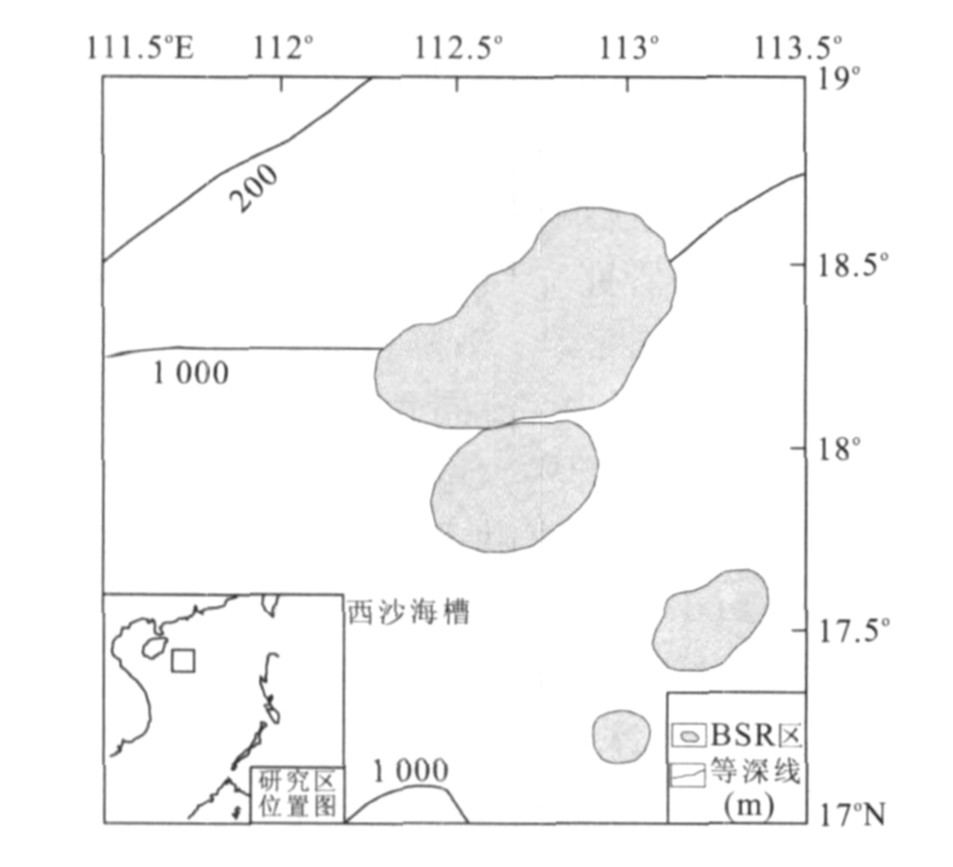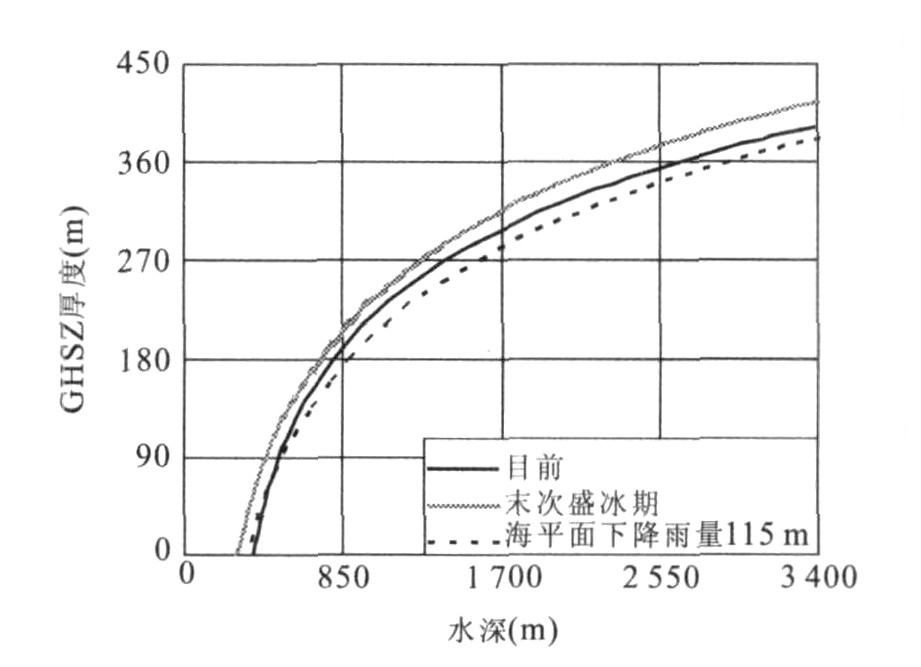The Change of Gas Hydrate Reservoir and Its Effect on Environment in Xisha Trough since the Last Glacial Maximum
-
摘要: 利用Milkov和Sassen的模型计算了目前及末次盛冰期时西沙海槽天然气水合物的稳定带(GHSZ) 厚度及资源量, 讨论了末次盛冰期以来海洋底水温度增加和海平面升高对西沙海槽天然气水合物储库变化的影响.计算结果表明, 底水温度增加使GHSZ厚度减薄, 资源量减少; 而海平面上升使GHSZ厚度增加, 资源量增加, 但底水温度变化对GHSZ厚度和资源量的影响比海平面变化的影响更大.西沙海槽末次盛冰期时GHSZ平均厚度约为299m, 天然气水合物资源量约为2.87×1010m3, 甲烷数量约为4.71×1012m3; 目前的GHSZ平均厚度约为287m, 天然气水合物资源量约为2.76×1010m3, 甲烷数量约为4.52×1012m3.由此可见, 自末次盛冰期以来西沙海槽的GHSZ平均厚度减薄了~12m, 大约1.1×109m3的天然气水合物分解释放了1.9×1011m3的甲烷, 这些甲烷可能对环境产生了重要影响.Abstract: In this article, Milkov and Sassen's model is selected to calculate the thickness of the gas hydrate stable zone (GHSZ) and the amount of gas hydrate in the Xisha Trough at present and at the last glacial maximum (LGM), respectively, and the effects of the changes in the bottom water temperature and the sea level on these were also discussed. The average thickness of the GHSZ in Xisha Trough is estimated to be 287 m and 299 m based on the relationship between the GHSZ thickness and the water depth established in this study at present and at LGM, respectively. Then, by assuming that the distributed area of gas hydrates is 8 000 km2 and that the gas hydrate saturation is 1.2% of the sediment volume, the amounts of gas hydrate are estimated to be ~2.76×1010 m3 and ~2.87×1010 m3, and the volumes of hydrate-bound gases are ~4.52×1012 m3 and ~4.71×1012 m3 at present and at LGM, respectively. The above results show that the thickness of GHSZ decreases with the bottom water temperature increase and increases with the sea level increase, wherein the effect of the former is larger than that of the latter, that the average thickness of GHSZ in Xisha Trough had been reduced by ~12 m, and that 1.9×1011 m3 of methane is released from approximately 1.1×109 m3 of gas hydrate since LGM. The released methane should have greatly affected the environment.
-
Key words:
- gas hydrate /
- last glacial maximum (LGM) /
- bottom water temperature /
- sea level /
- Xisha Trough
-
图 1 西沙海槽地理位置(杨涛等, 2006)
Fig. 1. Location of the Xisha Trough
-
Bains, S., Corfield, R. M., Norris, R. D., 1999. Mechanisms of climate warming at the end of the Paleocene. Science, 285: 724-727. doi: 10.1126/science.285.5428.724 Booth, J. S., Winters, W. J., Dillon, W. P., et al., 1998. Major occurrences and reservoir concepts of marine clathrate hydrates: Implications of field evidence. In: Henriet, J. P., Mienert, J., eds., Gas hydrates: Relevance toworld margin stability and climate change. Geol. Soc. London Spec. Publ., 137: 113-128. Brewer, P. G., 2000. Gas hydrates and global climate change. In: Holder, G. D., Bishnoi, P. R., eds., Gas hydrates: Challenges for the future. Ann. N. Y. Acad. Sci., 912: 195-199. Buffet, B. A., 2000. Lathrate hydrates. Annual Review of Earth and Planetary Sciences, 28: 477-507. doi: 10.1146/annurev.earth.28.1.477 Carpenter, G., 1981. Coincident sediment slump/clathratecomplexes on the U. S. Atlantic continental slope. Geo. Mar. Lett. , 1: 29-32. doi: 10.1007/BF02463298 Cathles, L. M., Chen, D. F., 2004. A compositional kineticmodel of hydrate crystallization and dissolution. J. Geophys. Res. , 109: B08102. Chamberlain, J. W., Foley, H. M., MacDonald, G. J., et al., 1983. Climate effects of minor at mospheric constituents. In: Clark, W. C., ed., Carbon dioxide review, 1982. Oxford Univ. Press, New York, 255-277. Chen, D. F., Cathles, L. M., 2003. A kinetic model for the pattern and amounts of hydrate precipitatedfroma gas steam: Application to the Bush Hill vent site, green canyon block 185, gulf of Mexico. J. Geophys. Res. , 108 (B1): 2058. Chen, D. F., Li, X. X., Xia, B., 2004. Distribution of gas hydrate stable zones and resource predictionin the Qiong-dongnan basin of the South China Sea. Chinese Journal of Geophysics, 47 (3): 483-489 (in Chinese with English abstract). https://www.researchgate.net/publication/292409424_Distribution_of_gas_hydrate_stable_zones_and_resource_prediction_in_the_qiongdongnan_basin_of_the_South_China_Sea Chen, L., Peng, X. C., Miu, W. C., 1995. Stratimagic interpretationin northern slope of South China Sea (7). China University of Geosciences Press, Wuhan, 92-106 (in Chinese). Chen, Z., Yan, W., Chen, M. H., et al., 2006. Advance ingas hydrate dissociation and fate of methane in marinesediment. Advances in Earth Science, 21 (4): 394-400 (in Chinese with English abstract). Clennell, M. B., Hovland, M., Booth, J. S., et al., 1999. Formation of natural gas hydrates in marine sediments 1. Conceptual model of gas hydrate growth conditioned by host sediment properties. J. Geophys. Res. , 104: 22985-23003. doi: 10.1029/1999JB900175 Dickens, G. R., 2000. Methane oxidation during the late Paleocene thermal maximum. Bull. Soc. Geol. Fr. , 171: 37-49. Dickens G. R., 2001. On the fate of past gas: What happens to methane released fro, a bacterially mediated gas hydrate capacitor? Geochemistry, Geophysics, Geosystems, 2: 5. doi: 10.1029/2000GC000131 Dickens, G. R., Castillo, M. M., Walker, J. C. G., 1997. Ablast of gas in the latest Paleocene: Simulating first-order effect of massive dissociation of oceanic methane hydrate. Geology, 25: 259-262. Dickens, G. R., O'Neil, J. R., Rea, D. K., et al., 1995. Dissociation of oceanic methane hydrate as a cause of the carbon excursion at the end of the Paleocene. Paleoceanography, 10: 965-971. doi: 10.1029/95PA02087 Fang, Y. X., Shentu, H. G., Jin, X. L., 2002. Computation ofthickness of hydrate stability zone in Okinawa Trough. Mineral Deposits, 21 (4): 414-418 (in Chinese withEnglish abstract). Feng, W. K., Xue, W. J., Yang, D. Y., et al., 1988. Geo-environment of northern South China Sea in Late Quaternary. Guangdong Science and Technology Press, Guangzhou, 42-43, 62 (in Chinese). Ge, Q., Wang, J. S., Xiang, H., et al., 2006. Computation ofthickness of gas hydrate stability zone and potential volume of gas hydrate in South China Sea. Earth Science-Journal of China University of Geosciences, 31 (2): 245-249 (in Chinese with English abstract). Gong, Z. S., Li, S. T., 1998. Continental margin basin analysis and hydrocarbon accumulationin the northern SouthChina Sea. Science Press, Beijing, 510. Hantoro, W. S., 1995. The Sunda and Sahul continental plat-form: Lost land of thelast glacial continent inthe SE A-sia. Quat. Inter'l, 29/30: 129-134. doi: 10.1016/1040-6182(95)00015-B Haq B., 1998. Gas hydrates: Greenhouse nightmare? Energy panaceaor pipedream? GS A Today, 8: 1-6. Hesselbo, S. P., Groecke, D. R., Jenkyns, H. C., et al., 2000. Massive dissociation of gas hydrate during a Jurassic oceanic anoxic event. Nature, 406: 392-395. doi: 10.1038/35019044 Jacobsen, S. B., 2001. Gas hydrates and deglaciations. Nature, 412: 691-693. doi: 10.1038/35089168 Jahren, A. H., Arens, N. C., Sarmiento, G., et al., 2001. Terrestial record of methane hydrate dissociation in theEarly Cretaceous. Geology, 29 (2): 159-162. doi: 10.1130/0091-7613(2001)029<0159:TROMHD>2.0.CO;2 Jeffrey, P., Atanas, V., Lyobomir, D., 2002. Changes of theBlack Sea gas hydrate reservoir from the last glacialmaximumto present. Proceeding of the fourth international conference on gas hydrates, Yokohama, 19-23. Katz, M. E., Pak, D. K., Dickens, G. R., et al., 1999. The source and fate of massive carboninput duringthelatest Paleocenethermal maximum. Science, 286 (5444): 1531-1533. doi: 10.1126/science.286.5444.1531 Kennedy M. J., Christie-Blick N., Sohl L. E., 2001. Are Proterozoic cap carbonates and isotopic excursions a record of gas hydrate destabilization following earth's coldest intervals? Geology, 29: 443-446 Kennett, J. P., Cannariato, K. G., Hendy, I. L., et al., 2000. Carbon isotopic evidence for methane hydrate instabilityduring Quaternary interstadials. Science, 288: 128-133. doi: 10.1126/science.288.5463.128 Kennett, J. P., Cannariato, K. G., Hendy, I. L., et al., 2003. Methane hydrates in Quaternary climate change. AGU, 1-217. Kienast, M., Steinke, S., Stattegger, K., et al., 2001. Synchronous tropical South China Sea SST change and greenl and warming during deglaciation. Science, 291: 2132-2134. doi: 10.1126/science.1057131 Koch, P. L., Zachos, J. C., Gingerich, P. D., 1992. Correlation between isotope records in marine and continentalcarbon reservoirs near the Palaeocene/Eocene boundary. Nature, 359: 319-322. Kvenvolden, K. A., 1993. Gas hydrates-geological perspective and global change. Rev. Geophys. , 31: 173-187. doi: 10.1029/93RG00268 Kvenvolden, K. A., Barnard, L. A., 1983. Hydrates of natural gas in continental margins. In: Watkens, J. S,, Drakem C, L., eds., Studies in continental margin geology. Am. Assoc. Pet. Geol. Mem., 34: 631-640. Leifer, I. S., MacDonald, I., 2003. Dynamics of the gas fluxfromshallow gas hydrate deposits: Interaction betweenoily hydrate bubbles and the oceanic environment. Earth and Planetary Science Letters, 210: 411-424. doi: 10.1016/S0012-821X(03)00173-0 Lu, Z. Q., Wu, B. H., 2002. Experimental research on geo-chemical methods for prospecting gas hydrates in marine sediments. Geoscience, 16 (3): 229-304 (in Chinesewith English abstract). MacDonald, G. J., 1990a. Role of methane clathrates in past and future climates. Clim. Change, 16: 247-281. doi: 10.1007/BF00144504 MacDonald, G. J., 1990b. The future of methane as an energyresource. Ann. Rev. Energy, 15: 53-83. doi: 10.1146/annurev.eg.15.110190.000413 Maslin, M. A., Mikkelsen, N., Vilela, C., et al., 1998. Sea-level and gas-hydrate-controlled catastrophic sediment failures of the Amazonfan. Geology, 26: 1107-1110. Matsumoto, R., 1995. Causes of the δ13C anomalies of carbonates and a new paradigm 'Gas-Hydrate Hypotheses'. J. Soc. Japan, 101: 902-924. Milkov, A. V., Sassen, R., 2000. Thickness of the gas hydrate stability zone, Gulf of Mexico contimental slope. Mar. Pet. Geol. , 18: 981-991. Milkov, A. V., Sassen, R., 2001. Estimate of gas hydrate resource, northwestern Gulf of Mexico continental slope. Marine Geology, 179: 71-83. doi: 10.1016/S0025-3227(01)00192-X Milkov, A. X., Sassen, R., 2003. Two-dimensional modeling of gas hydrate decomposition in the northwestern Gulf of Mexico: Significance to global change assessment. Global and Planetary Change, 36: 31-46. doi: 10.1016/S0921-8181(02)00162-5 Milkov A. V., 2004. Global estimates of hydrate-bound gas in marine sediments: How much is really out there? Earth-Science Reviews, 66: 183-197. doi: 10.1016/j.earscirev.2003.11.002 Monnin, E., Indermühle, A., Dallenbach, A., et al., 2001. At mospheric CO2 concentrations over the last glacialtermination. Science, 291: 112-114. doi: 10.1126/science.291.5501.112 Nisbet, E. G., 1990. The end of the ice age. Canadian Journal of Earth Science, 27: 148-157. doi: 10.1139/e90-012 Norris, R. D., Röhl, U., 1999. Carbon cycling and chronology of climate warming during the Palaeocene/Eocene transition. Nature, 401: 775-778. doi: 10.1038/44545 Novosel, I., Spence, G. D., Hyndman, R. D., 2005. Reduced magnetization produced by increased methane flux at agas hydrate vent. Marine Geology, 216 (4): 265-274. doi: 10.1016/j.margeo.2005.02.027 Padden, M., Weissert, H., De Rafelis, M., 2001. Evidencefor Late Jurassic release of methane from gas hydrate. Geology, 29 (3): 223-226. doi: 10.1130/0091-7613(2001)029<0223:EFLJRO>2.0.CO;2 Petit, J. R., Jouzel, J., Raynaud, D., et al., 1999. Climate andat mospheric history of the past420000years fromtheVostokice core, Antartica. Nature, 399: 429-436. doi: 10.1038/20859 Retallack, G. J., 2001. A 300-million-year record of at mospheric carbon dioxide fromfossil plant cuticles. Nature, 411: 287-290. doi: 10.1038/35077041 Satoh, M., Maekawa, T., Okuda, Y., 1996. Estimation ofamount of methane and resources of natural gas hydrates in the world and around Japan. Jour. Geol. Soc. Japan, 102: 959-971. Severinghaus, J. P., Brook, E. J., 1999. Abrupt climatechange at the end of the last glacial periodinferred fromtrapped air in polar ice. Science, 286: 930-933. doi: 10.1126/science.286.5441.930 Severinghaus, J. P., Sowers, T., Brook, E. J., et al., 1998. Timing of abrupt climate change at the end of the younger Dryas interval fromthermally fractionated gases inpolar ice. Nature, 391: 141-146. doi: 10.1038/34346 Sibuet, M., Olu, K., 1998. Biogeography, biodiversity andfluid dependence of deep-sea cold-seep communities atactive and passive margins. Deep-Sea Research Part Ⅱ, 45: 517-567. doi: 10.1016/S0967-0645(97)00074-X Sloan E. D. 1998. Clathrate hydrates of natural gases. Marcel Dekker, New York. Song, H. B., 2003. Researches on dynamic evolution of gas hydrate system (Ⅰ): Its development in geological history. Progress in Geophysics, 18 (2): 188-196 (in Chinese with English abstract). Spanger N. S., Hayes D. E. 1995. Gravity, heat flow, and seismic constraints on the processes of crust extension: Northern margin of the South China Sea. Journal of Geophysical Research, 100: 22447-22483 doi: 10.1029/95JB01868 Summerhayes, C. P., Bornhold, B. D., Embley, R. W., 1979. Surficial slides and slumps on the continental slope andrise of south west Africa: A reconnaissance study. Mar. Geol. , 31: 265-277. doi: 10.1016/0025-3227(79)90037-9 The Multidisciplinary Oceanographic Expedition Team ofAcademia Sinica to Nansha Islands, 1993. Quaternary sedimentary geology of Nansha Islands and adjacent seaarea. Hubei Science and Technology Press, Wuhan, 1-383 (in Chinese). Wang, H. Y., Sun, C. Y., Zhang, H. B., et al., 2005. Origin andgenetic model of potential gas hydrates in Xisha Trough, South China Sea. Marine Geology and Quaternary Geology, 25 (4): 85-91 (in Chinese with English abstract). Wang P., Prell W. L., Blum P., et al., 2000. Proc ODP Init Repts, 184 [CD-ROM ]. Ocean drilling program. Texas A & M University, College Station TX 77845- 9547, USA. Xue, W. J., Huo, C. L., Si, G. X., 1991. The paleoclimate andpaleoceanography of Late Quaternaryin northern SouthChina Sea. Marine Geology Research, 4: 1-96 (in Chinese with English abstract). https://www.sciencedirect.com/science/article/pii/002532279500008M Yang, T., Jiang, S. Y., Ge, L., et al., 2006. Geochemical characteristics of sediment pore water from site XS-01in the Xisha Trough of South China Sea and their significance for gas hydrate occurrence. Quaternary Sciences, 26 (3): 442-448 (in Chinese with English abstract). Yao, B. C., 2001. The gas hydrate in the South China Sea. Journal of Tropical Oceanography, 20 (2): 20-28 (inChinese with English abstract). https://www.sciencedirect.com/science/article/abs/pii/S0920410512000113 Yao, B., Zeng, W., Hayes, D. E., et al., 1994. The geological memoir of South China Sea surveyed jointly by China & USA. China University of Geosciences Press, Wuhan, 1-102. Yu, X. G., Li, J. B., 2004. Advances in gas hydrate dissociation and effects on the ecology and environment. Advances in Earth Science, 19 (6): 947-954 (in Chinesewith English abstract). https://en.cnki.com.cn/Article_en/CJFDTOTAL-DXJZ200406010.htm Zeng, W. P., Zhou, D., 2003. GIS-aided estimation of gas hydrate resources in southern South China Sea. Journal of Tropical Oceanography, 22 (6): 35-45 (in Chinesewith English abstract). Zhu, Y. H., Rao, Z., Liu, J., et al., 2005. Geochemical anomalies and their implication from site14, the XishaTrough, the South China Sea. Geoscience, 19 (1): 39-44 (in Chinese with English abstract). doi: 10.1007/s10872-008-0039-8 陈多福, 李绪宣, 夏斌, 2004. 南海琼东南盆地天然气水合物稳定域分布特征及资源预测. 地球物理学报, 47 (3): 483-489. doi: 10.3321/j.issn:0001-5733.2004.03.018 陈铃, 彭学超, 谬宛岑, 1995. 南海北部陆坡区地震地层解释. 南海地质研究(七). 武汉: 中国地质大学出版社, 92-106. 陈忠, 颜文, 陈木宏, 等, 2006. 海底天然气水合物分解与甲烷归宿研究进展. 地球科学进展, 21 (4): 394-400. doi: 10.3321/j.issn:1001-8166.2006.04.008 方银霞, 申屠海港, 金翔龙, 2002. 冲绳海槽天然气水合物稳定带厚度的计算. 矿床地质, 21 (4): 414-418. doi: 10.3969/j.issn.0258-7106.2002.04.013 冯文科, 薛万俊, 杨达源, 等, 1988. 南海北部晚第四纪地质环境. 广州: 广东科技出版社, 42-43, 62. 葛倩, 王家生, 向华, 等, 2006. 南海天然气水合物稳定带厚度及资源量估算. 地球科学——中国地质大学学报, 31 (2): 245-249. https://www.cnki.com.cn/Article/CJFDTOTAL-DQKX200602014.htm 卢振权, 吴必豪, 2002. 海底水合物地球化学探测方法的试验研究. 现代地质, 16 (3): 229-304. https://www.cnki.com.cn/Article/CJFDTOTAL-XDDZ200203014.htm 宋海斌, 2003. 天然气水合物体系动态演化研究(Ⅰ): 地质历史演变. 地球物理学进展, 18 (2): 188-196. doi: 10.3969/j.issn.1004-2903.2003.02.003 王宏语, 孙春岩, 张洪波, 等, 2005. 西沙海槽潜在天然气水合物成因及形成地质模式. 海洋地质与第四纪地质, 25 (4): 85-91. https://www.cnki.com.cn/Article/CJFDTOTAL-HYDZ200504018.htm 薛万俊, 霍春兰, 司桂贤, 1991. 南海北部晚第四纪古气候及古海洋学. 南海地质研究, 4: 1-96. 杨涛, 蒋少涌, 葛璐, 等, 2006. 南海北部陆坡西沙海槽XS-01站位沉积物孔隙水的地球化学特征及其对天然气水合物的指示意义. 第四纪研究, 26 (3): 442-448. doi: 10.3321/j.issn:1001-7410.2006.03.017 姚伯初, 2001. 南海的天然气水合物矿藏. 热带海洋学报, 20 (2): 20-28. doi: 10.3969/j.issn.1009-5470.2001.02.004 于晓果, 李家彪, 2004. 天然气水合物分解及其生态环境效应研究进展. 地球科学进展, 19 (6): 947-954. doi: 10.3321/j.issn:1001-8166.2004.06.012 曾维平, 周蒂, 2003. GIS辅助估算南海南部天然气水合物资源量. 热带海洋学报, 22 (6): 35-45. doi: 10.3969/j.issn.1009-5470.2003.06.006 中国科学院南沙综合科学考察队, 1993. 南沙群岛及其临近海区第四纪沉积地质学. 武汉: 湖北科学技术出版社, 1-383. 祝有海, 饶竹, 刘坚, 等, 2005. 南海西沙海槽S14站位的地球化学异常特征及其意义. 现代地质, 19 (1): 39-44. doi: 10.3969/j.issn.1000-8527.2005.01.006 -










 下载:
下载:




